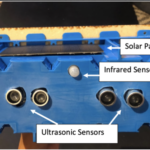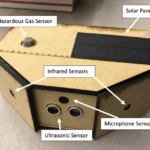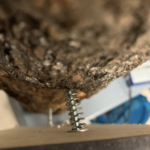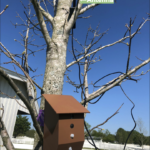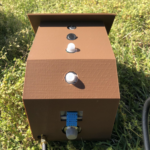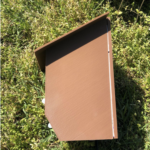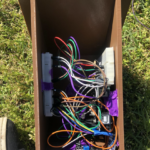In our design process, the team went through three prototypes before landing on our final design. On this page, you will see images and descriptions of each prototype and why things were designed the way they were. For further information on the sensors and the power supply, please navigate to their respective pages.
Prototypes
First Prototype
- First prototype, completed in November of 2019.
The first prototype had a solar panel, infrared sensor, two ultrasonic sensors, and a hazard gas sensor on the bottom (not in view). It was housed in a hard, blue plastic container. The plastic was difficult to cut into thus making the holes for the sensors irregularly shaped.
Second Prototype
- Second prototype, completed in January of 2020.
The sensors on this prototype remained the same besides a reduction in the number of ultrasonic sensors and an increased in the number of infrared sensors. The infrared sensors were also placed on an angle to increase their range. For environmental reasons and ease of design, the team switched to laser cutting wood for the housing. While it was much easier to modify for the sensors, a big downside to this method of housing was that it was not waterproof.
Third Prototype
- Third prototype, completed in February of 2020.
- Mounting system.
The sensors on this prototype remained the same. With this prototype, the team decided to use a simple rectangular box for the housing. The infrared sensors were no longer on angles because this positioning didn’t significantly improve the range of the sensors. Also, reducing the number of joints would make the box easier to waterproof. The mounting system was also finalized with this prototype. The mounting system requires using two wood screws, four washers, and two springs. By installing the device in this manner, the tree is able to grow without being harmed by the device.
Final Prototype
- Final prototype, completed in March of 2020.
- View of device from the bottom up.
- View of housing from the side.
- View of the interior of the device with sensors installed.
The final sensors included in the device are a solar panel, two infrared sensors, a hazardous gas and temperature sensor, a transmitter, antenna, and microphone. With the final prototype the team decided to 3D print the housing in the shape of a birdhouse. This was done for two reasons. The first reason is the overhang at the top of the housing prevents rain from falling on the sensors. To further prevent water entry, the team will be using Loctite Clear Silicone Waterproof Sealant to close the gaps between the housing and the sensors. The second reason is a birdhouse blends in better with the environment. We don’t want our device to get in the way of people enjoying the outdoors. 3D printing the device means fewer joints to waterproof.

